SECTION 39
DESIGN REVIEW GUIDELINES
Subsections:
39.01 Architectural Design for Single-Family Residential Uses
39.02 Architectural Design for Multifamily Residential Uses
39.03 Architectural Design for Commercial and Industrial Uses
39.03-01 Architectural Design Generally
39.03-02 Architectural Character and Style
39.03-05 Building Materials and Textures
39.03-07 Architectural Details
39.03-08 Climate and Energy Conservation
39.04 Site Design for Commercial and Industrial Uses
39.04-01 Site Design Generally
39.04-04 Building Placement and Orientation
39.04-05 Climatic Considerations
39.04-06 Linkage and Circulation
39.04-08 Service Areas, Mechanical Equipment, Refuse Enclosures, etc.
39.04-09 Fences and Walls and Other Screening Devices
39.04-10 Drive-Through Facilities
39.01 Architectural Design for Single-Family Residential Uses
Residential architectural design is intended to achieve a harmonious design relationship in the design and character of homes within a neighborhood and the community that use the materials and forms that complement the southwest environment and which acknowledge a harmonious relationship of structures to their neighbors and to the community but not necessarily a duplication of any specific style.
a. Design Criteria
Common issues that define the character and theme of a neighborhood are:
1. Design elements and detailing shall be continued completely around the structure with the same importance put on all sides. Such design elements shall include:
A. Articulation of wall planes, a variety of roof forms, variation in roof heights, and ridgelines, or other architectural treatments.
B. Accent treatments and finishing details such as pop-outs, reveals, and recesses are required around all windows and doors, gable ends and wall expanses on all elevations. Window frames and mullions must be factory finished.
C. Garage doors are to be made from sectional metal or high-quality wood or equivalent. Window panels are encouraged to be integrated into the design of the garage door.
D. Pillars, columns, and posts are to be sized to be proportional to the size of the home.
E. Where possible, the garage should have a side entry or be set back from the front of the home. If neither is possible, the garage design should not be more prominent than the entry or main section of the house.
2. Linear repetitive streetscape appearance and building facades shall be avoided by providing variations between the front elevations.
3. A variety of roof forms and ridgelines shall be provided.
4. All building materials shall be durable and appropriate for their intended use.
5. Colors shall relate well to the house and area and be appropriate for the proposed style of architecture. Colors that are included in the city’s color palette are encouraged. Alternative colors will require specific approval by the city’s design review board.
6. Metal flashing, vents, pipes, electrical panels and other exposed metal shall be painted to match the color of the roof or house.
7. All ground mounted mechanical equipment shall be completely screened from public view.
8. All fireplace chimneys shall be boxed to avoid exposed metal flues.
9. Porches, balconies, and/or seating areas on the front of the home are encouraged to be incorporated into the design of the dwelling unit to provide covered area to protect residents from weather, enhance the elevation, provide more depth to the dwelling unit and create a sense of arrival.
10. All front entryways shall be lighted and open. Side entries and doorways are allowed if the door is visible from the street and not behind the garage or living area. Narrow front entries shall be designed in a manner so as to avoid potential safety hazards and crime prevention through environmental design (CPTED) issues.
11. A minimum of one window on the first floor shall be visible from the street.
12. If patio covers are provided as a standard feature, they shall match the architecture of the house and the roof material.
13. Integrated patio covers are encouraged. Columns must be proportional and appropriate to the house. If a flat roof is provided, it must be screened with a parapet or similar treatment.
14. Clay or concrete tile is encouraged as a roof material.
15. The front of the house should be illuminated for safety.
16. Garages should not be the dominant feature on the lot but shall be located a minimum of five feet back from the entry feature or living area in medium and large lot developments. In small lot developments the garage should be located in excess of the five-foot setback requirement.
17. If side entry garages are incorporated into a development with the driveway internal at the front of the house or external on the side of the lot, the front facing wall must be architecturally integrated with the design of the home.
18. Courtyard walls, a maximum three feet in height in the front yard or side yards, or a maximum of six feet within the allowable building envelope and adjacent to the driveways to create gathering areas, are encouraged.
19. Provide decorative pilasters, molding, cornices, brick, stone, masonry or other facade and accent materials to encourage curb appeal.
20. Add brick, river rock, natural stone, or masonry to elevations in each neighborhood to add a distinctive finishing touch to the home in a single builder neighborhood.
21. Roof mounted mechanical equipment is prohibited.
22. Each home shall have a location for the storage of trash receptacles which is fully screened from public view.
23. The location of the house on the lot, windows, orientation, building height and location of on-site open space shall consider preservation of the privacy of adjacent development.
24. Custom homes when developed on large lots or within an existing neighborhood without an HOA must take into consideration the design of the existing homes on the adjacent lots, in an effort to provide compatibility within the neighborhood. All homes are subject to review and approval of the design review board. (Ord. 13-191 § 1 (part))
39.02 Architectural Design for Multifamily Residential Uses
Residential architectural design is intended to achieve a harmonious design relationship in the design and character of homes within a neighborhood and the community that use the materials and forms that complement the southwest environment and which acknowledge a harmonious relationship of structures to their neighbors and to the community but not necessarily a duplication of any specific style.
a. Building Architecture
The design of the buildings in multiple residence developments must not only be appropriate to regional architecture and climate, but provide a high-quality living environment for residents that combines privacy and convenience with a sense of neighborhood. While personal preferences in style and design will always exist, there are underlying fundamentals of good architectural design that must be followed.
b. Building Elevations
1. Repetitive use of a single building configuration and repetition in building facades shall be avoided. There should be a rhythm to building elevations which adds unity and interest without becoming monotonous.
2. The proportions and details of building components and materials shall reflect a residential character, particularly on the ground floor level. Use building features of a human scale, sized for their function.
3. The scale of a building should be reduced by visually dividing it and giving character to the individual units within. This is accomplished by doing some or all of the following:
A. Vary building heights.
B. Use offsets in wall planes on all elevations to create strong shaded shadow lines which define edges and enhance architectural proportions, adding visual interest to otherwise flat planes.
C. Large spans of uninterrupted roof planes are discouraged. Roof features, such as parapets, hips, and gables, are encouraged, featuring patios, balconies, and a strong fenestration in the building elevations.
D. Use architectural details on cornices, handrails, or parapet edges.
4. Individual unit entries shall not open directly onto public spaces, parking lots, collector walkways, or streets. Recessing doorways into the building achieves unit individuality. Arches, gateways, entry courts, and roof forms should be used to shelter doorways and foster a sense of arrival. Entries should be covered and private, yet visible for safety.
5. Treatment of stairways is important to the appearance of multistory buildings. Stairs shall be designed according to the following techniques:
A. Freestanding stairways shall not make a straight run from upper floors to the ground. Landing(s) are required and shall be constructed with right-angle turn(s). Stairways shall be incorporated into, and compatible with, the overall development. Stairs that are well recessed into buildings and are largely hidden from view may be left open, if doing creates a more open and airy entry courtyard area.
B. Stairways shall be built into courtyards and entry areas and not simply hung off the sides of buildings.
C. Detail stairways by using insets, reveals, decorative tile or stucco texturing, decorative handrails, newel posts, etc.
6. All balconies and patios should be covered to shade them and protect them from weather. All patios shall be enclosed by screen walls to separate them from the public spaces adjacent to them and patios of units next door. Balconies shall be separated from adjacent balconies by walls of the same design and construction as the building. Solid walls or open structures may enclose the open sides of balconies, but materials shall be compatible with the buildings.
7. Patio covers shall be integrated into buildings. Flat patio roofs shall be screened with a parapet wall. Supports must be masonry or stuccoed and painted wood structures. No exposed wood posts or metal pipes.
8. Windows shall be placed to provide light into the living spaces from as many directions as possible.
9. Use clerestory windows, glass block, or other similar methods when providing privacy.
10. Recess building walls and windows. Pop-outs, projections, shadow boxes, planter boxes, sills, awnings (using materials that can withstand sun exposure), or shutters shall accent windows. Window frames and mullions shall be finished with baked enamel paint or anodized. Features such as accent trim, divided windows, and rectangular or round openings are encouraged.
11. Blank walls shall be avoided. All walls should be given shadow and depth by articulation, using projections and recesses, and using features such as planters and fountains to break up the expanse of blank walls. In no case should the length of blank walls exceed fifty feet.
12. All mechanical equipment, regardless of location, shall be screened from view, using the following techniques:
A. Rooftop equipment shall be hidden behind parapets or other structures designed into the building.
B. Ground-mounted equipment such as exterior transformers, utility pads, satellite earth station, cable TV, and telephone boxes shall be installed out of view or screened with a combination of walls and landscape.
C. Mechanical control equipment and meters shall be internal or ground-mounted and screened with walls, enclosures, or landscaping.
13. Parking covers and detached garages shall be designed to be compatible with other project buildings and shall satisfy the following requirements:
A. Parking covers and garages shall be constructed of durable materials (no exposed wood or plastics), and be the minimum height necessary to perform their function.
B. Parking covers shall be constructed with fascias, parapets, recessed lights, and other details that give a finished look. Garages should repeat details of the main buildings in their design, and treat all sides of the buildings which are visible.
C. Parking covers compatible for solar installations are encouraged.
D. Parking covers and garages should match the main building color.
E. All garages shall have operable doors.
14. Where separate structures are necessary for accessory uses, they shall be of materials, design, and colors compatible with the main buildings.
c. Materials and Colors
1. Building materials and color selection should be simple and consistent throughout the development. The project should blend and complement the surrounding area. Contrasting materials and colors as accents are encouraged; however, the basic palette should be simple and relatively unobtrusive. Materials shall be durable and appropriate for the climate. Stucco, stone, and masonry shall be primary building materials, with clay or concrete tiles (or equivalents) used as roof materials.
2. Chimneys shall be constructed of the same materials and textures used in the building. Exposed flues are prohibited. (Ord. 13-191 § 1 (part))
39.03 Architectural Design for Commercial and Industrial Uses
(Ord. 13-191 § 1 (part))
39.03-01 Architectural Design Generally
Architectural design is intended to achieve a compatible relationship in the design and character of buildings and other built elements in the community but not necessarily a replication of any specific historic or contemporary style. (Ord. 13-191 § 1 (part))
39.03-02 Architectural Character and Style
a. The intent of this section is to establish guidelines to ensure that development demonstrates a quality of architecture within the city that is responsive to and builds upon the aesthetic identity of the heritage of the community rather than supporting or encouraging design based on corporate identification or market prototypes. The following are not acceptable:
1. Literal transplant of architectural styles not indigenous or compatible to this area.
2. Corporate signature buildings or structures.
3. Buildings that derive their image primarily from applied treatments that express corporate identity.
4. Buildings that are designed or stylized to reflect a corporate or franchise prototype image.
b. Buildings that occupy a pad or portion of a building within a project or shopping center shall share a similar design characteristic and design.
c. Four-sided architecture is required. Design elements shall be incorporated into each of the four sides of the building and all sides of a building must be compatible with the front elevation. (Ord. 13-191 § 1 (part))
39.03-03 Proportion and Scale
Elevation and perspective drawings, photographic simulations, models and the use of other graphic means are encouraged and may be required to illustrate or fully explain how a development will look and be compatible with the surrounding community.
a. Proportion
Architecture of commercial and industrial projects, including individual freestanding structures, shall be designed so that they are in proportion to elements within the project site, adjacent properties and within the area they are to be located.
1. Building proportions with horizontal emphasis are generally preferred and desired. Vertical design that exaggerates the building height shall be avoided.
2. Vertical elements that are taller than the majority of a building, such as towers, or narrow vertical masses can add visual interest and identity to a building. Care must be taken to not allow the vertical elements to overpower the building design. Taller buildings or portions of a building should be located internal to a site or structure so that buildings step down in height as they reach the edges of the site or structure.
3. Variations in building height, roofline, and grade definition; designing buildings in proportion with the mass and floor area of existing development; and using harmonious materials, colors and complementary landscaping may all be used to mitigate the perceived height of a building.
4. Varied spacing of elements in a facade is desirable over repetitive features. “Storefront” glass walls in excess of twenty feet in length are not desirable.
b. Scale
1. New development should mimic the predominant scale of any existing development and use elements of similar scale.
2. Building elements and facades should be kept intimate and close to human size so as to achieve a sense of human scale and interest that relates to pedestrian movement through the project.
3. A mixture of scales may be appropriate in less pedestrian areas.

(Ord. 13-191 § 1 (part))
39.03-04 Building Massing
All developments shall incorporate means of reducing the visual size and bulk of buildings in order to maximize integration of the built environment with the natural environment.
a. Buildings should be designed in a manner that reduces apparent bulk by dividing the building into smaller masses with each mass relating to the internal function of the building.
b. Large or long continuous wall surfaces shall be avoided. Building surfaces should be relieved with a change of wall plane that provides strong shadow and visual interest. Facade undulation should be sufficient to create strong shadow lines.
c. Variation in the roof silhouette can provide design interest and contribute to the architectural and landscape character of the city.
d. The design of the building’s base should demonstrate a strong connection with the ground by using:
1. Low planters and walls.
2. Base plantings with shrubs and trees.
3. Architectural veneers, wainscoting and other treatments, including varying colors, materials and textures.
e. Integrated covered walkways, trellises, and awnings that provide deep shadow are encouraged.
f. Upper or second levels of a building should be reduced in floor area and building mass to create roof terraces and outdoor spaces.
g. Pronounced eaves and distinct parapet designs and cornice treatments can be used to create a well-defined building top or roof line.
h. Clearly defined recesses and projections are encouraged to break up horizontal surfaces and to provide visual interest and definition using strong shadow and shade.
i. Entryway recesses, architectural projections, wall plane offsets and stepped building forms are all desirable to break up a building’s mass.
j. A facade not related to the rest of a building mass is strongly discouraged. A consistent level of detailing, patterning and finish on all sides of a building is encouraged.
k. Facade details on all elevations of a structure are encouraged.
l. All accessory structures should complement the architectural character of the primary building through the use of similar or complementary materials, colors and textures.
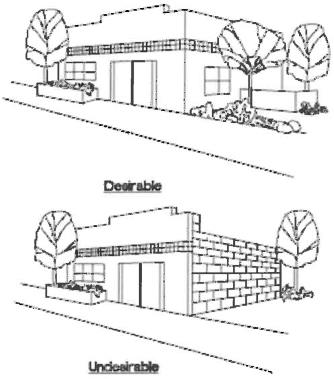
(Ord. 13-191 § 1 (part))
39.03-05 Building Materials and Textures
The use of native materials is desirable to create a “sense of place.” Manmade materials simulating natural materials are discouraged.
a. Every proposal shall demonstrate that the use of natural materials from the area has been studied.
b. In the southwest, natural textures are bolder and stronger than in many other areas of the country. Coarse and highly textured materials that create shadow patterns are desired.
c. River rock and sandstone, if used, should be applied so that it looks as natural as possible. It should be stacked or layered in a manner that gives a sense of mass and connectivity to the ground plane.
d. Concrete masonry block products that are integrally colored and have textured faces are desirable.
e. Wood elements and wood siding may be used in moderation and should be treated in a manner as to preserve it from the hot, dry climate.
f. Exposed aggregate concrete may be used for walkways or floors. Exposed, traditionally finished concrete may only be used in moderation and only when it can be demonstrated that it is complementary to overall design scheme.
g. Windows and large areas of glass should be deeply recessed. Nonreflectivity is desirable over deeply tinted and/or other highly reflective treatments.
h. Encouraged pedestrian-oriented surface materials include:
1. Exposed aggregate colored concrete.
2. Stamped and/or colored and textured concrete.
3. Interlocking pavers.
4. Earth-tone concrete.
i. Discouraged external finishes visible to the public include:
1. Cedar or other wood shakes.
2. Reflective, shiny or mirror-like materials.
3. Exposed, unfinished foundation walls.
4. Exposed plywood or particleboard.
5. Glass curtain walls.
6. White, black, or reflective roofs.
7. Unplastered/exposed standard CMU.
8. White exterior surfaces on skylights.
9. Shiny/reflective acrylic, metallic or similar finishes, unless limited to trim and hardware.
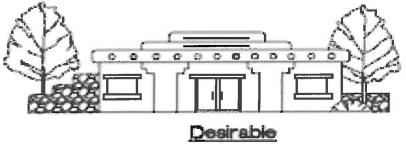
(Ord. 13-191 § 1 (part))
39.03-06 Color
a. Color should be used to blend development into its surrounding natural environment.
b. Accent colors may be used for architectural trim not to exceed ten percent of any single wall surface.
c. Color should be used to reduce and articulate the apparent scale of building masses.
d. A palette of compatible hues has been developed by the city to reduce visual impacts and should be consulted when choosing the color palette for buildings.
e. Stains and flat paints are desirable.
f. High gloss and factory finished metal products and other products that are conducive to high reflectivity are unacceptable.
g. Matte finishes are encouraged.
h. Light reflective colors and hues may be used for accent and trim.
i. Bright and glossy or fluorescent colors are strongly discouraged.
j. Corporate signature colors are strongly discouraged, unless compatible with the overall color scheme and design of the entire project. (Ord. 13-191 § 1 (part))
39.03-07 Architectural Details
Surfaces, details, ornament and other elements that enrich and accent architectural character of development are encouraged.
a. Desirable details include:
1. Stonework, keystones, wall caps, planters, fountains, monument sign bases, etc.
2. Covered walkways and balconies.
3. Cornices, moldings, accent lighting and artwork.
4. Benches, earthen pots, etc.
5. Exposed beams and columns.
6. Exterior stairways and ramps that are integral to the primary structure.
7. Columns, low screen walls, raised landscape planters, etc., are desirable elements to be placed in front of primary entrances with an entry framing in excess of six feet in width.
b. Undesirable details include:
1. Colored plastic and fiberglass.
2. Shiny/reflective metal.
3. False fronts.
4. Corporate signature design and color schemes.
5. Poorly proportioned pueblo “steps” in parapets. (Ord. 13-191 § 1 (part))
39.03-08 Climate and Energy Conservation
Well thought-out configuration may reduce energy consumption and provide comfortable indoor and outdoor spaces, and shall include the following elements:
a. Shaded exterior walls through the use of canopies, trellises, complementary awnings, etc.
b. Roof overhangs for shade and weather protection.
c. Protected outdoor spaces and landscaping that create micro-climate conditions.
d. Horizontal offsets in an elongated building elevation. (Ord. 13-191 § 1 (part))
39.04 Site Design for Commercial and Industrial Uses
(Ord. 13-191 § 1 (part))
39.04-01 Site Design Generally
Site design addresses topography, vegetation and landscape features, and drainage characteristics of the site. Not all of the criteria set forth in this chapter will be applicable to all sites; however, site design approval will be reviewed and approved based on substantial compliance with the following criteria and other criteria set forth in this chapter:
a. Consistency of site grading and finished floor elevations with the natural characteristics of the site’s underlying topography.
b. Integration into the natural environment such as drainage ways, vegetation masses and mature trees.
c. Building design and location that takes advantage of the natural topography of the site and compatibility with the apparent mass and bulk of large structures with their settings.
d. Minimization of disturbance of land for roads, parking areas or structures.
e. Preservation of existing native or specimen vegetation, including vegetation replanted on site or elsewhere.
f. Compliance with all applicable federal, state and municipal codes. (Ord. 13-191 § 1 (part))
39.04-02 Spaces
Buildings and outdoor space design shall provide amenities for employees and public use, including:
a. Shared driveways for accessing adjoining streets.
b. Linked internal vehicular circulation systems and cross-access easements.
c. Linked internal pedestrian systems with adjoining sites.
d. Linked open space systems and bicycle/pedestrian pathways.
e. Perimeter open space and landscape buffers as required by Section 30.
f. Common location and access for refuse collection.
g. Drainage and retention of storm water.
h. Infrastructure improvements and utility easements.
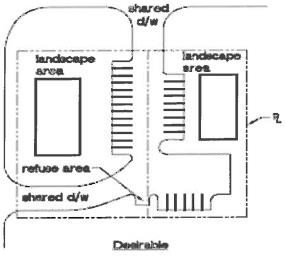
(Ord. 13-191 § 1 (part))
39.04-03 Viewsheds
It is essential to preserve existing views while incorporating the best views from the subject property into the design. It is also important to consider the probable impact of a new development on future buildings and developments. Two types of views are important and will be considered.
a. Views from within the Site
1. Protection of views of special features such as the neighboring mountains.
2. Preservation of view corridors by the placement of new buildings or trees.
b. Views into the Site
1. Identification of areas and corridors from which the new development will be seen from outside the site.
2. Minimize negative visual impact.
3. Alignment of courtyards, surface parking and open spaces with view corridors from adjacent sites. (Ord. 13-191 § 1 (part))
39.04-04 Building Placement and Orientation
a. Circulation
Building placement should allow for interconnected walkways and parking drives. This has the advantage of convenience and enhanced pedestrian accessibility, increased building exposure and enhanced safety.
b. Building Entries
Identifiable building entries that consider pedestrian use as well as motor vehicle uses are encouraged.
c. Common Open Space
Buildings should be connected to and/or clustered around common open spaces where practicable.
d. Pedestrian Connectivity
A strong pedestrian connection should be provided to the street edge and adjacent properties to promote connectivity and area-wide pedestrian pathway and corridors.
e. Corner Buildings
1. The primary mass of a corner building shall not be placed at an angle to the corner.
2. Principal building entry shall be oriented towards adjoining streets.
3. Pedestrian access through the site should be provided at the corner.
4. Parking located in the rear.
5. Design of buildings to mitigate any negative visual impact to adjacent residences and public open space.
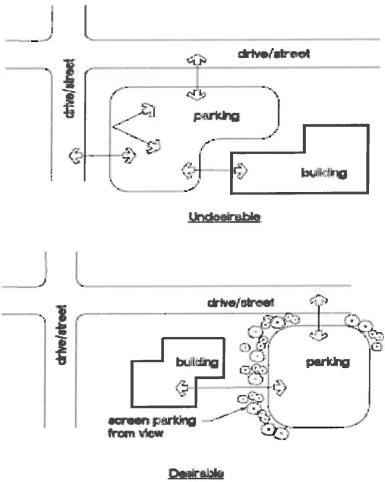
(Ord. 13-191 § 1 (part))
39.04-05 Climatic Considerations
a. Building Orientation
When designing site for building placement, summer heat gain is an important factor to consider, and low afternoon/evening sun angles cannot be effectively shaded or mitigated with structural overhangs alone.
b. Courtyards
Courtyards that have southern and eastern exposures and opportunities for shade from overhead trellises and landscaping are encouraged.
c. Landscape Location
Landscape areas, rather than parking lots, abutting the east and west sides of courtyards and buildings are encouraged. Arizona Department of Water Resources approved trees should be planted on south and west building exposures.
d. Covered Parking
Covered parking is encouraged to provide relief from summer heat and seasonal rains. Parking structures should be architecturally compatible with the remainder of the development.
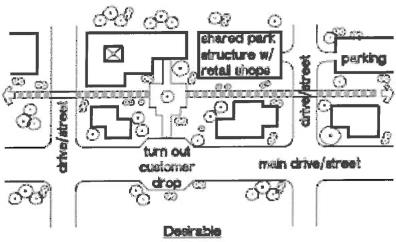
(Ord. 13-191 § 1 (part))
39.04-06 Linkage and Circulation
a. Pedestrian Linkages
The location of pedestrian and vehicular circulation patterns shall be coordinated with adjacent sites, buildings and uses. Review criteria include:
1. Provision of adequate space for pedestrian gatherings and pedestrian circulation. It is desirable to develop a network of covered arcades.
2. Interconnection of the project with existing sidewalks and pathways. Interconnected walkways should be designed with similar and/or complementary details, colors, finishes, and materials.
3. Interconnecting courtyards and passageways that interconnect and align with existing courtyards in adjacent developments.
4. Pedestrian paths that are clearly visible and provide visual links between neighboring buildings and parking areas through the use of:
A. Covered arcades and walkways.
B. Courtyards.
C. Unified landscape design.
D. Consistent/complementary paving materials.
E. Minimal interruption of pedestrian paths by vehicular circulation and parking lots.

b. Courtyards
Courtyards and patios shall be included. These spaces should be designed for the comfort and convenience of pedestrians. A courtyard or plaza may serve as the focus of a site or building. All open courtyards or plazas shall incorporate landscaping, shaded areas and seating. The edges of courtyards should contain retail shops, restaurants, offices and pedestrian activity. Blank walls should be minimized. Art should be considered to enliven common spaces.
c. Street Furniture
Seating, drinking fountains, trash receptacles, and information directories should be included in the pedestrian areas.
d. Outdoor Dining
Outdoor dining areas are encouraged and should be used in conjunction with courtyards and plazas. Outdoor dining should be oriented away from noise generating activities.
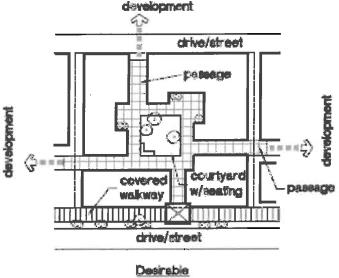
e. Parking Lot Walkways
Safe, attractive pedestrian circulation to and through parking areas shall be provided. Pedestrian circulation should be simple and generally follow landscape islands and lead directly to buildings. When it is necessary for pedestrians to cross vehicular traffic flows, clearly delineated crosswalks shall be provided. The use of differing colors, textures and materials is encouraged to delineate crosswalks. Bicycle parking should be provided in a manner as not to interfere with pedestrian movement. Parking lots that contain four or more parallel rows of parking shall include separated pedestrian walks.
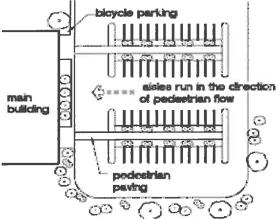
(Ord. 13-191 § 1 (part))
39.04-07 Parking Lots
Parking areas shall be designed to reduce the visual dominance of vehicles. Existing, healthy trees and natural vegetation shall be preserved whenever feasible. Parking areas shall:
a. Be screened by buildings and landscaping.
b. Be screened from public view or surrounded by landscaped buffers in order to buffer visual intrusion and headlight glare.
c. Be covered to provide visual screening. Covered parking structures shall be architecturally compatible with the surrounding development. When covered parking is not practical, landscape islands shall be used to provide visual buffering and shade.
d. Be designed to accommodate queuing within internal driveways and not on through streets.
e. Provide safe view angles and pedestrian crossings at all intersections of driveways and streets. (Ord. 13-191 § 1 (part))
39.04-08 Service Areas, Mechanical Equipment, Refuse Enclosures, etc.
a. Services Areas and Refuse Enclosures
Service areas, loading zones and refuse enclosures shall be located to the rear or side of a building, or to an internal location, screened from view from public streets, courtyards, plazas, pedestrian corridors and neighboring properties. Refuse enclosures shall not be a visual focal point from an entry driveway or principal pedestrian access. Landscape planting to screen views of service areas, loading zones and refuse enclosure is required. Where feasible, service areas and refuse enclosures should be clustered together in order to facilitate service and greater effective screening. The impact of these uses can be mitigated by:
1. Placement away from residential pedestrian oriented areas.
2. Construction of solid masonry walls around the service area or refuse enclosure in a manner to be compatible with the design of the neighboring buildings. Refuse enclosures should have nontransparent gate closures and a side entrance.
3. Use of dense landscaping for screening purposes.
4. Clustered service areas and refuse enclosures.
b. Shopping Carts
Shopping carts shall be stored within the building or screened with a wall that has been designed as an integral component of the building’s architecture.
c. Mechanical Equipment
Mechanical and electrical equipment, utility cabinets, solar collectors, satellite dishes and communication equipment shall be concealed from view of public streets and neighboring properties.
1. Utility cabinets and pedestals should not be located within parking lot landscape islands or public rights-of-way. Utility cabinets, pedestals and other above ground utility infrastructure should be clustered and screened to the extent allowable by operational requirements. Such equipment shall be painted or integrally colored a tone that is neutral to its setting.
2. Rooftop and ground mounted mechanical equipment and electrical service equipment shall be screened from public view with materials architecturally compatible with the finishes and character of the principal structure. All rooftop and ground mounted mechanical and electrical equipment (including satellite dishes) shall be screened to a height of the tallest equipment and/or integrated with the building design.
3. Vending machines (freestanding or attached) shall not be visible from the street or neighboring properties.
4. The following equipment and uses shall be screened:
A. Trash and refuse collection.
B. Mechanical equipment such as air conditioners, pumps and motors.
C. Propane tanks and other storage tanks.
D. Electrical equipment including switching equipment and transformers.
E. Valves and vents.
F. Rooftop skylights (to prevent unwanted light effects at night).
5. Surface/ground mounted equipment such as air conditioners, tanks and dumpsters shall be screened by appropriate walls and fences and softened visually with vine and shrub plantings.
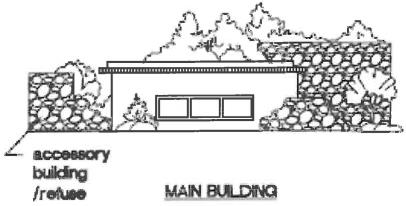
(Ord. 13-191 § 1 (part))
39.04-09 Fences and Walls and Other Screening Devices
a. Acceptable Materials
Fences and walls that can be viewed by the general public shall be architecturally compatible with the principal buildings in color, design and materials. The following materials are encouraged for use where visible to the public:
1. Native stone.
2. Landscaped earth berms.
3. Vine covered trellises.
4. Textured block or stucco walls compatible with adjacent buildings (painted CMU block walls are acceptable but not encouraged).
5. Walls and fences greater than forty feet in unbroken length should be designed to increase shadow patterns, provide interesting visual effects and reduce bulk/mass through design elements, like wall undulation.
b. Unacceptable materials are:
1. Chain link or open wire fencing (except in landscape screened service and security areas); redwood slat inserts, with suitable staining and landscape screening, are acceptable where appropriate.
2. Razor wire.
3. Corrugated metal.
4. Plastic.
5. Nontextured or unfinished concrete or block (CMU) walls for walls that can be viewed by the general public. (Ord. 13-191 § 1 (part))
39.04-10 Drive-Through Facilities
Drive-through facilities for banks, restaurants and drugstores shall be architecturally integrated into the development and minimize conflicts to surrounding vehicular and pedestrian patterns. Drive-through windows, menu boards, sound equipment, stacking lanes and headlight glare shall be located to minimize impacts on adjacent uses and shall be screened from public view. Architectural covering of these areas is encouraged, but must be designed as an integral part of the overall building design. Menu board call-box volumes must be controlled and monitored to not have sound project beyond the property line. (Ord. 13-191 § 1 (part))


